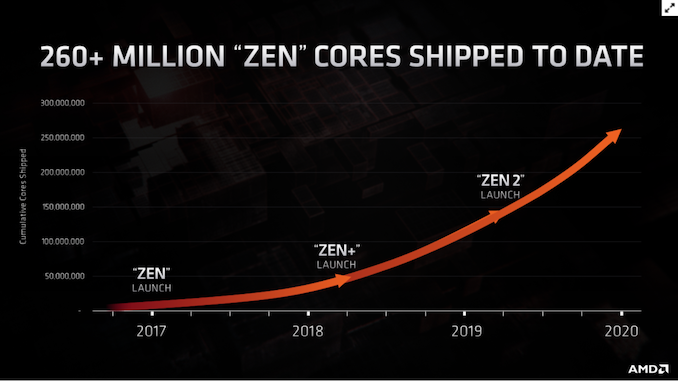AMD Shipped 260 Million Zen Cores by 2020
by Dr. Ian Cutress on March 5, 2020 4:56 PM EST- Posted in
- CPUs
- AMD
- Zen
- AMD FAD 2020

Today’s Financial Analyst Day 2020 from AMD is full of small nuggets of information. With the company building its foundation on its new x86 Zen high-performance architecture, keeping track of the finances is a good marker to find out how well its products are doing. Another marker is how many chips are in the wild. To that end, AMD's CTO Mark Papermaster presented this graph:
Since the launch of the first Zen products in 2017, the company states that it has shipped 260,000,000 Zen cores to date. It is worth noting that this is cores, not chips, and so there’s a mix of everything from 2-core to 64-core products in there. But this counts consumer, enterprise, commercial, and mobile products. With the launch of the Zen 2 based consoles later this year, this number is expected to shoot up by a significant margin.
Side reading this graph, we get the following numbers:
2017-2018: ~30m cores
2018-2019: 80m cores (~110m total)
2019-2020: 150m cores (~260m total)
Interested in more of our AMD Financial Analyst Day 2020 Coverage? Click here.











33 Comments
View All Comments
Xyler94 - Friday, March 6, 2020 - link
OEMs buy Intel because Intel is giving them a discount. It's that plain and simpletimecop1818 - Saturday, March 7, 2020 - link
OEMs buy Intel because that's what consumers want.Korguz - Saturday, March 7, 2020 - link
as Xyler said, intel HAS to be offering discounts now to keep them buying intel, only a fool like you, would still by intelXyler94 - Monday, March 9, 2020 - link
To be fair Korguz, Intel does have a place in the market. And that's what competition is good for.But for general purpose use, AMD is on top right now, and that should push Intel to think of General uses, not specialized ones (AVX-512, Gaming at extreme framerates).
Deicidium369 - Sunday, April 12, 2020 - link
AMDs place in the market benefits both Intel and Nvidia. When people start throwing around terms like monopoly, both can point to AMD (while holding in a laugh like the Biggus Dickus sketch in Life of Brian).AMD is not on top of anything. Superfluous cores, no integrated graphics, and abysmal clock rates, massive software issues from Driver and firmwares.. They do put out some cracking good Marketing - which is good reading when taken with the much much lower actual performance. When software developers solve the decades old "How do I easily make my code more parallel" then maybe all those "extra" cores will be of benefit outside of some benchmarks - What exactly is Cinebench used for in the real world? I know it does video encoding/transcoding - but is it the market leader? I know no one who does video for a living uses Blender - pretty much just some benchmarking stuff, right?
Deicidium369 - Sunday, April 12, 2020 - link
The fools are buying AMD - cool to root for underdog. Buying Intel or AMD or Ford or whatever does not make you smarter, foolish, taller or more attractive to the opposite sex (or same sex, whatever)... It is a consumer product, and 90% of consumers have decided that the consumer products bearing the Intel name sell better than the other brand most consumers have never heard of or see, rightly so, as a budget systems that runs almost as good as Intel. In a world with Intel, why would you go with something that only compares itself to Intel.Buy what you want and can afford and enjoy it. No one really cares.
Xyler94 - Monday, March 9, 2020 - link
You are denser than Intel's failed density plans for 10nm, Timecop.People don't give a shit what powers their laptop, they only care if it "performs good". You give any consumer 2 laptops, one with an AMD CPU, and one with an Intel CPU, none would care. However, if you said Laptop 1 was 200$ cheaper, they'd take that in a heartbeat, no matter if it's Intel or AMD. Consumers are extremely simple people, and the reason OEMs stuck with Intel was because there wasn't a good AMD alternative, and because Intel was giving them discounts/incentives. Remember that AMD tried giving (I think it was HP or someone else) a huge amount of FREE CPUs, but they didn't accept it because it would still not be good for their finances, because they were relying on Intel incentives.
So no, OEMs aren't buying Intel CPUs because it's "what people want", it helps their bottom line, that's it, that's all. Consumers care about pricing, not the little details like what CPUs in their laptop. I know, I worked Best Buy for almost 2 years, and I've had to explain to people why that 300$ laptop isn't a good deal over the 500$ one... Many, many, many times...
Deicidium369 - Sunday, April 12, 2020 - link
Funny - Tiger Lake reaches that 2.7x density. You need to update your information. Do you think the first gen of 14nm is as dense as the the most recent? TSMC would have renamed that node from 14 to 13 to 13 to 10 each time a + was added. 16/14/12 is all the same node, just improvements, like intel 14nm. TSMC still has work thru the issues with cobalt, which Intel now has down pat.OEMs are giving their large customers what they want. Reasonable amount of usable cores, integrated graphics that are sufficient for typical office usage and a long unbroken line of upgrades and stability. Price is not always the most important metric - and having to add that discrete video card add complexity, a line item in the BoM and added load on IT and Support to support that card.
IF HP could have found a customer for those "free CPUs" you can bet they would have sold them. The people making the decision what goes into the desktops and data centers are some of the same people who, in their earlier jobs, were the ones who had the clean up the Opteron ECC debacle... and after all those almost new Opteron systems being dumped and replaced with Intel - they still remember those long days and nights cleaning that mess up.
I am not constrained by finances - when the new Dell 13 2-in-1s were released, to replace my almost 2 year old Dell 13 2-in-1s - didn't even look at the price - turned out to be $2250 each including carrying case, extra PS Brick, etc. Didn't care about the price - so no, $200 would not have made a bit of difference here. Not everyone looks at price as the primary metric.
I never worked retail, but did assist a few friends make their choice at a Best Buy - and for them, it was AMD making a comparison to Intel, and in a world that has Intel, they chose Intel. Some people I know automatically would look at the tier above - they know that a laptop is a 2-3-4 year device and better to spend a little more upfront and get a machine that might last a little longer in usefulness.
HStewart - Tuesday, March 10, 2020 - link
This is oldest bias statement of them all - simple as that.Qasar - Wednesday, March 11, 2020 - link
not really, cause its probably still true, simple as that, unless you would like to post proof other wise there, hstewart ?